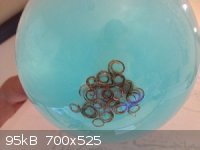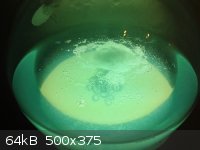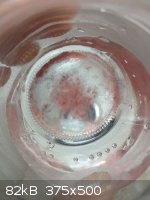Arsole
Hazard to Self
 
Posts: 52
Registered: 21-1-2012
Location: USA
Member Is Offline
Mood: Sleepy
|
|
Separation of Cu(OAc)2 and Zn(OAc)2
Lets say I have a mixture of 277g Cu(OAc)2 and 14g Zn(OAc)2 (both are hydrates). How would I go about separating them? (Purified
copper acetate is the desired outcome)
My first thought was to look at solubilities. Wiki says that Zn(OAc)2 has a solubility of 43g/100cc in 20o C H2O.
Wiki lists Cu(OAc)2 as having a solubility of 7g/100cc cold H2O and 20g/100cc hot H2O.
Would a good way to separate these compounds be to add the mixture to 200ml H2O at 20o C and stir for 15 minutes or so then
filter off the solid followed by a cold water wash.
Due to the higher solubility of the Zn(OAc)2 would the undissolved solid product be relatively pure Cu(OAc)2?
Any other methods or advice?
Thoughts, like fleas, jump from man to man, but they don't bite everybody.
-Stanisław Jerzy Lec
|
|
|
elementcollector1
International Hazard
    
Posts: 2684
Registered: 28-12-2011
Location: The Known Universe
Member Is Offline
Mood: Molten
|
|
Chill the solution to 0 degrees C - some copper acetate should drop out...
Elements Collected:52/87
Latest Acquired: Cl
Next in Line: Nd
|
|
|
Arsole
Hazard to Self
 
Posts: 52
Registered: 21-1-2012
Location: USA
Member Is Offline
Mood: Sleepy
|
|
Since they are salts and not in solution yet are you proposing just a simple recrystallization?
Thoughts, like fleas, jump from man to man, but they don't bite everybody.
-Stanisław Jerzy Lec
|
|
|
elementcollector1
International Hazard
    
Posts: 2684
Registered: 28-12-2011
Location: The Known Universe
Member Is Offline
Mood: Molten
|
|
Pretty much. Make a saturated solution (carefully), and chill the solution: Crystals of pure copper acetate should drop out. Let us know how it goes!

Elements Collected:52/87
Latest Acquired: Cl
Next in Line: Nd
|
|
|
Arsole
Hazard to Self
 
Posts: 52
Registered: 21-1-2012
Location: USA
Member Is Offline
Mood: Sleepy
|
|
Great I will give that a try. I am going to read up on some zinc tests in order compliment a melting point.
I had thought about the recrystallization but it seems the losses would be quiet high. The reagents are cheap though I guess.
Thoughts, like fleas, jump from man to man, but they don't bite everybody.
-Stanisław Jerzy Lec
|
|
|
12AX7
Post Harlot
    
Posts: 4803
Registered: 8-3-2005
Location: oscillating
Member Is Offline
Mood: informative
|
|
Hmm...
Toss in enough zinc to displace all the copper.
Dehydrate and crystallize.
After collecting the colorless crystals, realize something is wrong with this approach.
Buy copper acetate directly.
Open and consume beer.
 Ok, yes I can be a little useful, from time to time. Ok, yes I can be a little useful, from time to time.
Tim
|
|
|
Arsole
Hazard to Self
 
Posts: 52
Registered: 21-1-2012
Location: USA
Member Is Offline
Mood: Sleepy
|
|
Tim,
I'm not after the zinc acetate so displacement would not work.
I guess I could displace, then collect the copper precipitate, wash with HCl, and react that with acetic acid to yield the copper acetate. If I needed
to go that far I would have to crack open a beer. 
Thoughts, like fleas, jump from man to man, but they don't bite everybody.
-Stanisław Jerzy Lec
|
|
|
DJF90
International Hazard
    
Posts: 2266
Registered: 15-12-2007
Location: At the bench
Member Is Offline
Mood: No Mood
|
|
Copper should not react with acetic acid by itself. You'll need an oxidant in there. I've seen Pd(OAc)2 prepared from dissolution of Pd sponge
(basically finely divided Pd metal) in AcOH, with a small amount of nitric acid added (6mL azeotropic acid in 250ml AcOH?)... Perhaps a similar
approach could be used here. Almost certain I've seen AcOH and H2O2 used for copper specifically, actually.
|
|
|
unionised
International Hazard
    
Posts: 5102
Registered: 1-11-2003
Location: UK
Member Is Offline
Mood: No Mood
|
|
I'm fairly sure that zinc hydroxide is amphoteric.
|
|
|
blogfast25
International Hazard
    
Posts: 10562
Registered: 3-2-2008
Location: Neverland
Member Is Offline
Mood: No Mood
|
|
Yes but so is Cu(OH)2! At high pH it forms cobalt blue cuprate anions: Cu(OH)42-.
Fractionated crystallisation will lead to incomplete separation and is tedious. You'll only obtain relatively zinc free copper acetate but the zinc
acetate will always be soaked in copper acetate.
Separation by electroplating of the copper should be easy but requires redissolving of the obtained copper metal.
[Edited on 8-9-2013 by blogfast25]
|
|
|
AJKOER
Radically Dubious
    
Posts: 3026
Registered: 7-5-2011
Member Is Offline
Mood: No Mood
|
|
I agree electroplating is a good path.
Here is another original idea, which you may wish to test. Treat the solution with NaI. Per Wikipedia on CuI2 (see
http://en.wikipedia.org/wiki/Copper(I)_iodide ), it rapidly breaks down into the insoluble CuI and Iodine, whereas ZnI2 is more stable and highly
soluble.
Then, separate out and wash the CuI with water and alcohol (I guess one could weigh the cost of the alcohol versus the loss of elemental iodine that
may be recoverable (or not), in part, in the next step at the expense of introducing a dose of iodate). Next, treat with NaOH to form Cu(OH)2 (and the
soluble NaI which can be recycled) and react with Acetic acid.
The introduction of NaI (or KI) is interesting here as it is rare that one that sees one salt becoming very insoluble and the other very soluble.
[Edited on 9-9-2013 by AJKOER]
|
|
|
Arsole
Hazard to Self
 
Posts: 52
Registered: 21-1-2012
Location: USA
Member Is Offline
Mood: Sleepy
|
|
Since the precipitated copper would be very fine could it not be oxidized in an oven using atmospheric O2 and a little heat. This should
react with the acetic acid no problem. The first batch consists of zinc acetate and the second reaction yielding the pure copper acetate.
Yes, H2O2 will will provide the oxygen to drive the reaction to copper acetate.
I have never done electroplating and do not have the equipment to perform that currently though it sounds like an interesting project.
[Edited on 9-8-2013 by Arsole]
Thoughts, like fleas, jump from man to man, but they don't bite everybody.
-Stanisław Jerzy Lec
|
|
|
Arsole
Hazard to Self
 
Posts: 52
Registered: 21-1-2012
Location: USA
Member Is Offline
Mood: Sleepy
|
|
I decided to run some simple experiments last night.
I took pennies between, years 1962 < X< 1982 as these contain 95% copper 5% zinc.
Experiment 1
The penny was placed in a small container and 10ml 5% acetic acid was added. The entire oxide layer was removed at room temperature in about 10
minutes. No apparent further reaction with the unoxidized copper was observed.
Experiment 2
The same procedure except the acetic acid was slightly heated. The oxide layer was removed in less than 2 minutes. The reaction was left to sit for 20
minutes the copper produced a few tiny bubbles that clung to the surface of the coin, but very slowly.
Experiments 3,4
The same procedures as above however this time 10ml of H2O2 was added to the solution. The oxide layers reacted and both pennies
formed bubbles though the reactions were less than vigorous.

The penny to the left has a brown oxide layer. The penny to the right was the result of experiment 1.
Experiment 5
In order to see if the unoxidized pennies and acetic acid would react together. I removed the oxide layer from 4 pennies weighing 12.3g and added them
to a 1L RBF. To the flask was added 600ml of 5% acetic acid this was then left to reflux for 4 hours. After 4 hours obvious bubbles had formed on the
surface of the coins and the solution took on an extremely faint blue hue, indicating that a reaction had taken place although very very slowly.
Experiment 6
To a 1L RBF I added 250ml of 5% acetic acid, 250ml 3% H2O2 and 1 gram of copper turnings. At RT this mixture slowly formed very
fine bubbles that clung to the copper's surface. After heating the mixture to about 80oC vigorous reaction took place.

Characteristic blue color.

View of reaction illuminated from below.
Experiment 7
About 30ml of solution from experiment 7 was added to a small glass container. A few tiny pieces of Zn were added to the solution. The zinc started to
bubble immediately and after a few minutes the solution lost its blue coloring. After the zinc had stoped reacting the gray liquid (suspected zinc
acetate) was discarded. Deposited on the glass appeared to be a small amount of copper metal. The glass was washed with dilute HCl and rinsed with tap
water. To the glass containing the copper film was added 10ml acetic acid and 10ml hydrogen peroxide. After a few minutes of heating the
characteristic blue hue of copper acetate was observed.

After washing, the copper deposits can be seen
on the bottom of the glass.
More experiments to come  . .
[Edited on 9-9-2013 by Arsole]
Thoughts, like fleas, jump from man to man, but they don't bite everybody.
-Stanisław Jerzy Lec
|
|
|
AndersHoveland
Hazard to Other Members, due to repeated speculation and posting of untested highly dangerous procedures!
    
Posts: 1986
Registered: 2-3-2011
Member Is Offline
Mood: No Mood
|
|
If the separation was for an industrial process, it might be possible they could add acetylacetone as a solvent that would complex with the metal
ions. Then, with moderate heating and under reduced pressure these complexes can be relatively volatile. Under such conditions, fractional
distillation may be possible.
|
|
|
blogfast25
International Hazard
    
Posts: 10562
Registered: 3-2-2008
Location: Neverland
Member Is Offline
Mood: No Mood
|
|
Quote: Originally posted by AndersHoveland  | | Then, with moderate heating and under reduced pressure these complexes can be relatively volatile. Under such conditions, fractional distillation may
be possible. |
Selective solvent extraction would probably be easier.
But it all depends on what one wants to achieve: recovery of the copper for instance would be far easier by simple electroplating.
[Edited on 11-9-2013 by blogfast25]
|
|
|
DJF90
International Hazard
    
Posts: 2266
Registered: 15-12-2007
Location: At the bench
Member Is Offline
Mood: No Mood
|
|
Arsole: you seem like a nice guy and deserve a more suitable alias. Anyhow, you should ideally be using more concentrated acetic acid. Glacial is
probably overkill, but 50-80% would be a good start.
|
|
|
gsd
National Hazard
   
Posts: 847
Registered: 18-8-2005
Member Is Offline
Mood: No Mood
|
|
5% acetic acid. Looks like you are using table vinegar. And after adding 250 ml of H2O2 (3% medicinal grade?) it gets further diluted. Like DJF90 said
you need "home lab grade" chemicals not "kitchen grade".
Dilute AA (about 30 to 50 %) reacts fairly quickly with Cu under reflux and oxidizing conditions. You can even bubble air thru' the solution instead
of using H2O2 to effect oxidizing atmosphere.
Gsd
[Edited on 11-9-2013 by gsd]
|
|
|
Arsole
Hazard to Self
 
Posts: 52
Registered: 21-1-2012
Location: USA
Member Is Offline
Mood: Sleepy
|
|
| Quote: |
5% acetic acid. Looks like you are using table vinegar. And after adding 250 ml of H2O2 (3% medicinal grade?) it gets further diluted. Like DJF90 said
you need "home lab grade" chemicals not "kitchen grade". |
I have access to concentrated forms of these chemicals I used dilute because I am in a very small apartment and wanted to minimize the odor.
I am currently in the process of making my own vinegar from EtOH. I made and distilled the EtOH myself A few weeks ago. The acetic acid concentration
should finish at roughly 20%. I plan on turning this into glacial through the reaction of copper acetate with concentrated sulfuric acid. This will
provide me with a few weeks of simple yet fun experiments.
Thoughts, like fleas, jump from man to man, but they don't bite everybody.
-Stanisław Jerzy Lec
|
|
|
bismuthate
National Hazard
   
Posts: 803
Registered: 28-9-2013
Location: the island of stability
Member Is Offline
Mood: self reacting
|
|
you sould probably just put zinc in the solution for a while, filter, and then wash the filtrate with hcl. then you have copper disolve this in H2O2
and acetic acid. this may take a long time unfortunatley.
|
|
|